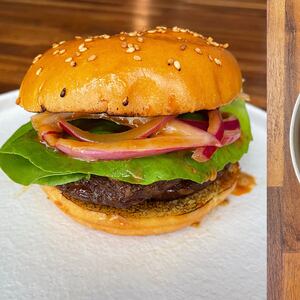Throughout her career as a cookbook author, Olia Hercules has taken deep dives into regional cuisines spanning Eastern Europe, including Georgia, Azerbaijan, Russia and beyond. Each of her three cookbooks, the latest of which is Summer Kitchens, is chock full of recipes for breads, stews and other dishes unique to each area. But there’s one dish many of these regional cuisines have in common: dumplings.
From manti in Turky to khinkali beloved across the Caucasus, these dumplings take many ornate forms, some rolled into perfect roses and others folded into something resembling a deliciously plump scarab beetle—and all are an economical way to use up leftovers or stretch simple ingredients into a filling meal. However, there’s only one dumpling that Hercules refers to as her “death row wish,” and that’s the simple, moon-shaped varenyky she grew up eating in Kakhovka, Ukraine, and which is featured in her first book, Mamushka.
“Everybody in the Ukraine would make it—it’s definitely one of those national dishes that’s quite stereotypical in a way,” says Hercules, whose mother first taught her how to make varenyky. “If you read Nikolai Gogol or something, you’ll have scenes where people are stuffing themselves with these varenyky, but it’s for a reason, right? It’s because they’re so bloody good.”
ADVERTISEMENT
Made from a simple dough of flour, eggs and water, varenyky (sometimes also referred to by their Polish name of pierogi) often have a vegetarian filling, like salty curd cheese or sauerkraut, and are served topped with crispy lardons, doused in butter and with cream for dipping.
“I love the contrast of that silky pasta, the really salty cheese inside and the sweet kind of butter and creme fraiche,” says Hercules, bragging that she can put down up to 30 in one sitting. “When it all kind of comes together, for me it’s like something happens in my brain and I’m just like, ‘Yes, this is it. I can die.’”
Hercules remembers eating varenyky at every occasion, including holidays (“you can put them into a Christmas borscht, which is really nice”) and family celebrations, or as an everyday snack. She didn’t learn how to make the dumplings until she took an interest in cooking as a teenager, but her son Sacha, who is 9, is already a varenyky fanatic. “We make them a lot when my mom visits us in the U.K. and he was so into dumplings from a very early age,” she says. “My mom and me and Sasha would sit down and make loads of them.”

These days, Hercules, who’s now based in London, finds that varenyky transcend time and distance—even the 1,800 miles separating London and Kakhovka. They’re one of the recipes she teaches during her popular virtual dumpling classes, of which there have been nearly 30 since the start of the pandemic. Some participants who live in America and other corners of the globe must even set their alarms for the middle of the night to join a session.
“It makes the hard work in all the other areas really worth it when you meet people that benefit and learn from your work,” she says. “I also love that it really lends itself to [a group]. If you’re at the table with your parents or your siblings or even your friends, have a dumpling party and catch up while you’re doing it. It’s such a beautiful thing.”
Ready to throw your own dumpling party? Hercules shares her advice for making expert varenyky every time.
When it comes to mixing varenyky dough, just keep calm.
“I feel like people get really kind of freaked out and discouraged when they mix the dough,” she says. “They try to start kneading it and it’s really hard to knead.”
That’s no cause for alarm, nor is its “weird and gnarled” appearance. The all-purpose flour in this dumpling dough needs time to relax and absorb the liquids (water and eggs) it’s mixed with. Bring the dough together until it’s somewhat homogenous, then let it be for 10 to 15 minutes. “When you knead it again, as if by magic, it’s relaxed and it will smooth out straight away,” she says. “Then, after you knead it again, leave it to relax [once more] before you roll it out.”
If you don’t plan to use the dough right away, tightly wrap it and place it in the refrigerator up to a day in advance (it may take on a slightly gray appearance but that won’t affect its flavor or workability) or in the freezer for up to three months (just refrigerate it overnight to thaw).
For a classic savory varenyky, Hercules goes for a simple curd cheese filling (recipe below) mixed with egg and plenty of salt. While she’ll typically use Czech syr or Polish twaróg cheese, feta is also a great option. In her latest cookbook, Summer Kitchens, she includes a spelt dumpling recipe (this dough takes a bit more skill to work with) stuffed with kraut and caramelized onions (recipe below). This filling uses only four ingredients and has a rich, almost creamy texture.
When it comes to filling varenyky, the possibilities are limitless. Much like Italian ravioli, the dough works seamlessly with meat or vegetable-based fillings. In select regions of Ukraine, it’s commonly stuffed with offal, like liver and lungs. The trick, no matter what you’re using, is to season the filling really well. The dough doesn’t include salt, so the filling should make up for it.
“Once I had some leftover chicken, which was roasted really nicely, so it wasn’t too dry. I minced through it with a knife until it was quite finely chopped and then mixed it with some finely chopped spring onions and a couple of other things.”
Varenyky is also an excellent vessel for seasonal fruit, from sour cherries to apricots (look for the strawberry varenyky recipe in her book Mamushka), especially when drizzled with honey or maple syrup. These sweet variations are steamed rather than boiled. “Don’t be scared to freestyle it a bit and substitute ingredients,” she says. “This is why those dumplings exist, to use up our leftovers.”
While you’ll come across plenty of images of perfectly moon-shaped varenyky with beautifully crimped edges, the fact is these Ukrainian dumplings require little fanfare. Especially if this is your first-time making dumplings, keep things as simple as possible.
Hercules likes to divide the dough into two equal pieces, keeping the dough she’s not currently working with under a slightly dampened towel to prevent it from “becoming leathery.” Then, you have two options: Roll out the dough into a circle roughly 12 inches in diameter and slice it into one-and-a-quarter inch squares or shape the dough into logs (à la Tollhouse cookie dough) and slice off what you need for a single varenyky as you go (roughly 10 grams per dumpling). If you’re afraid of the dough drying out too quickly, the latter may be the better option.
Then, place a rough teaspoon of filling in the center and simply fold the dough over and seal it tightly. “The dough should be forgiving and stick together—just make sure that you’re quite assertive when you’re pinching them together,” says Hercules. Dab a bit of water on the dough if you’re having trouble getting a good seal. But you need to make sure that you push all of the air out while sealing the dumplings, so they don’t burst when you boil them.
Keep assembled varenyky on a semolina-dusted baking sheet, under another damp towel until they’re ready to go into the boiling water (or into the freezer for a future treat). “When you’re putting them into the water to boil, straight away take a spoon and make sure that they haven’t stuck to the bottom of the pan,” she says. “Sometimes they sink and can get stuck and burn.”
“The varenyky have to be almost swimming in butter—I know that sounds really extreme,” says Hercules. “Regular melted butter is absolutely fine, but if you want it to be a little bit fancy-schmancy, brown butter is a good thing.”
Also, a side of sour cream is essential for dipping the varenyky. If you’re really going for an authentic Ukrainian experience, sprinkle crispy lardons and fried onions on top.
Can’t eat all of your varenyky in one sitting? Don’t worry; they make great leftovers. “If you boil more than you need, you can fry them the next day, morning, evening—whatever,” she says.
Makes 40–50 dumplings
For the dough:
INGREDIENTS
- 1 Large egg, lightly beaten
- .66 cup Water
- 2.66 to 3 cups All-purpose flour
- Semolina, polenta or extra flour for dusting trays
- Fine sea salt
- .25 cup Sour cream or creamy Greek yogurt, to serve
- Dumpling filling (recipes below)
DIRECTIONS
- First make the dough by mixing the egg and water together in a bowl. Then gradually add the flour and mix it in well. If you feel that there isn’t enough flour, add slightly more than the recipe states.
- Knead the dough on a well-floured work surface until it stops sticking to your hands. What you are looking for is an elastic dough.
- Wrap the dough in plastic wrap and let it rest in the refrigerator for 30 minutes to help the gluten relax.
- Next, make your chosen filling.
- Divide the dough into two pieces. Flour your work surface generously and roll out the dough into a circle 12 inches in diameter or until the dough is about 1/16 inch thick. Cut the dough into one-and-a-quarter inch squares—you should end up with about 20 to 25. Don’t throw away the scraps. These can be cooked along with the dumplings.
- Repeat with the second piece of dough.
- Have a well-floured baking sheet ready and some clean tea towels to keep your dumplings covered. This will prevent them from drying out while you work.
- Pop one teaspoon of filling into the center of each square, fold in half diagonally to create a triangular-shaped dumpling and press the edges together to seal. Place the varenyky on the floured baking sheet, making sure that they don’t touch each other.
- Have a large bowl with the melted butter ready.
- Bring a large saucepan of salted water to a boil and carefully add the varenyky. Boil them for a couple of minutes or until they float to the surface (about 5-8 minutes).
- Serve them with melted butter and unseasoned sour cream or full-fat yogurt. If you eat meat, some crispy fried salo, lardo or lardons also wouldn’t go amiss!
For the curd cheese filling:
INGREDIENTS
- .66 cup Syr or Polish twaróg or feta cheese
- Sea salt flakes
- .25 cup Butter, melted
- 1 Egg, lightly beaten
DIRECTIONS
Mix the cheese and the egg together in a bowl and season heavily with salt—it should be slightly over salted. Set aside or refrigerate if you don’t plan to make the dumplings right away.
For the kraut and caramelized onion filling:
INGREDIENTS
- 2 Onions, sliced not too thinly
- 2 Tbsp Canola oil
- 6 oz Sauerkraut
- pinch Salt
DIRECTIONS
- Heat the oil in a pan over low heat and add the onions and a pinch of salt—this will help to tease out the water from the onions, making them less likely to burn. Cook for about 10 minutes, covered with a lid or a cartouche (circle of baking parchment) to help things along. Keep an eye on them and stir from time to time, adding a splash of water and scraping the bottom of the pan if they start to look a bit dry.
- When they’re ready, the caramelized onions should be soft, dark and fragrant. If they look a little watery, drain off the excess liquid—the dumpling filling has to be as dry as possible. (As caramelizing onions takes a little while, I often make a big batch that I can keep in the fridge and use for a myriad of dishes.)
- Drain the sauerkraut well, squeezing it out in a colander (put the juice back into the jar). Stir the kraut into the caramelized onions—you should have roughly 10 ounces of filling. I like half kraut and half onion, but feel free to vary these proportions, depending on how sour your kraut is: if it is very sour, use less of it. Once you’ve got your filling how you want it, set it aside.







